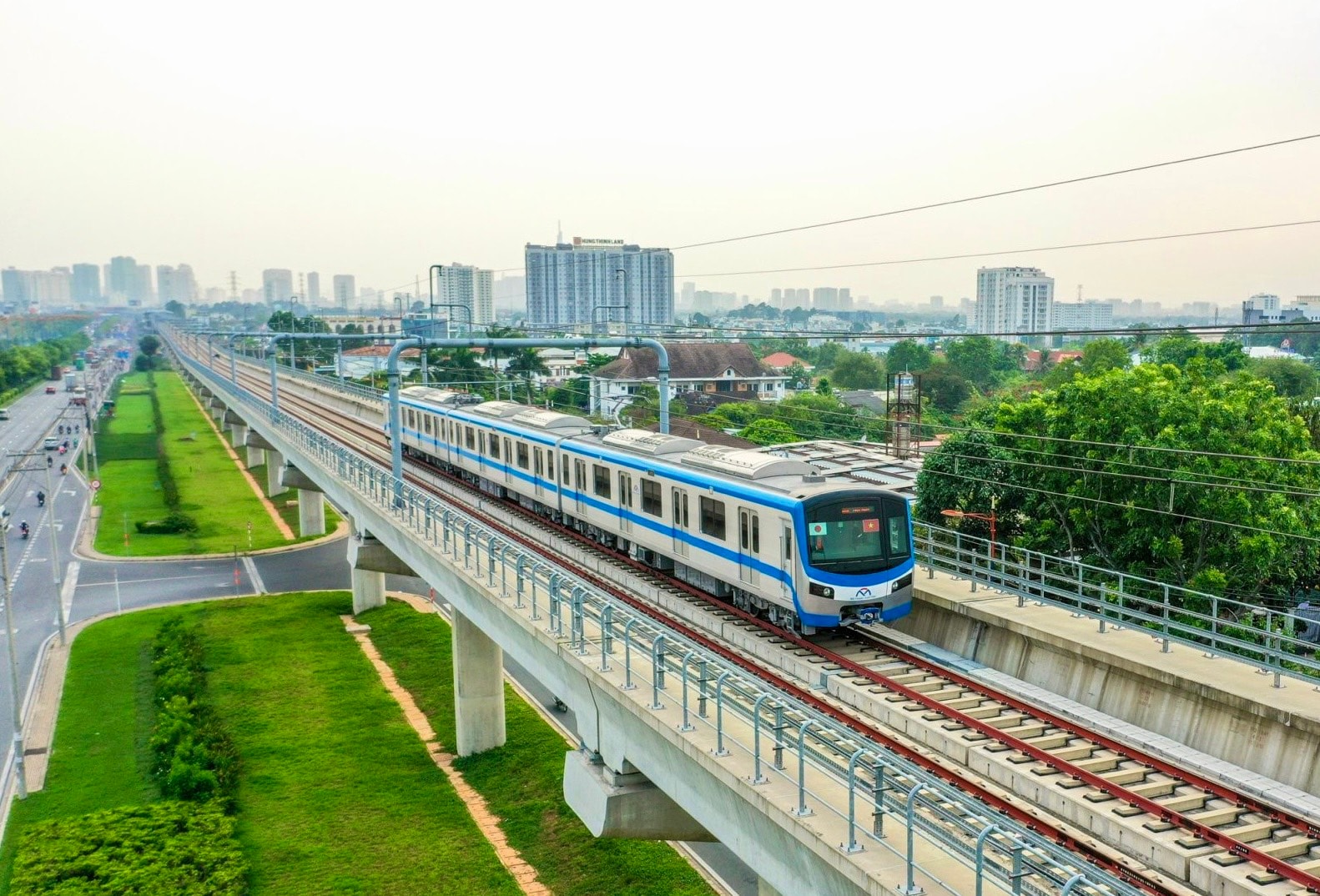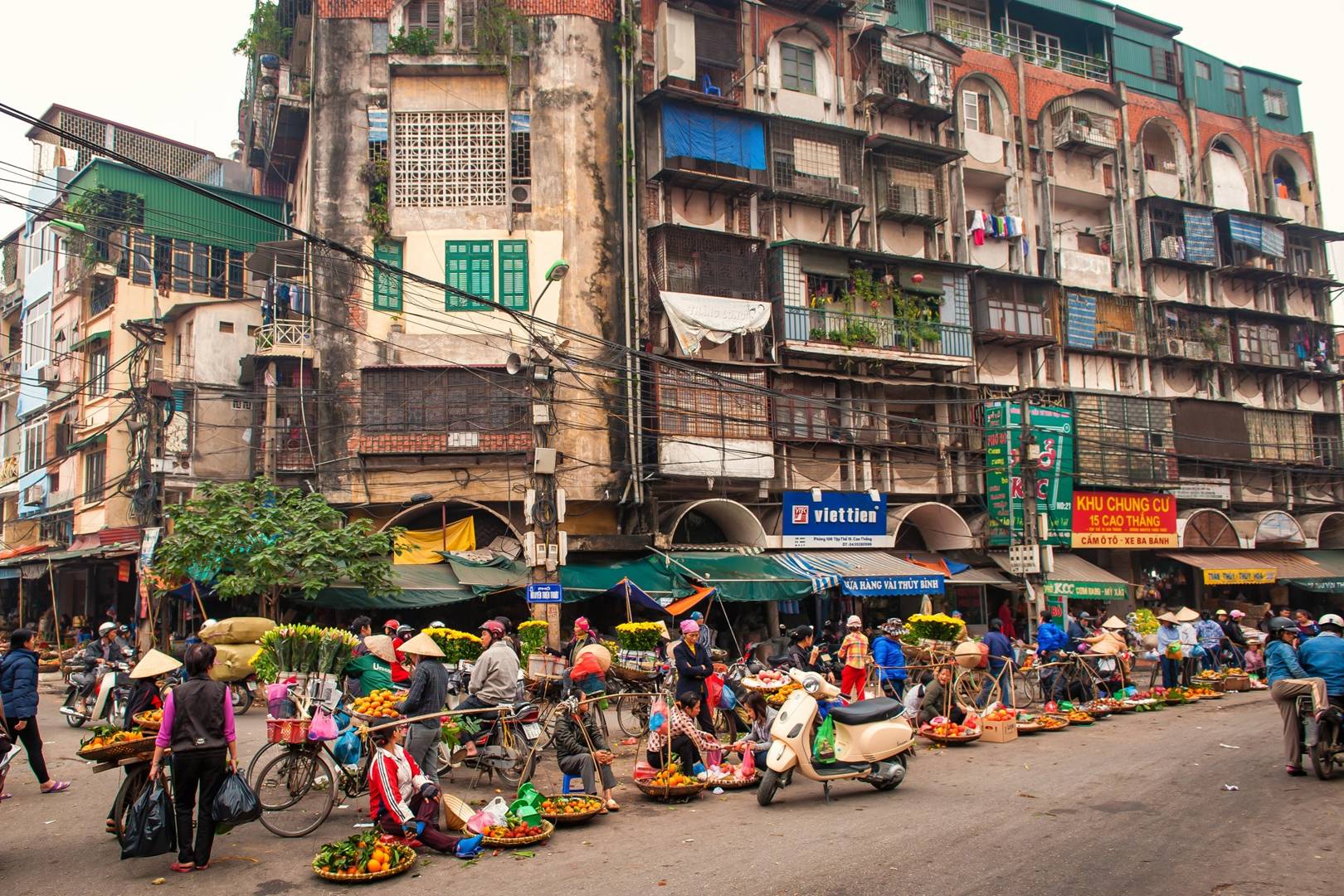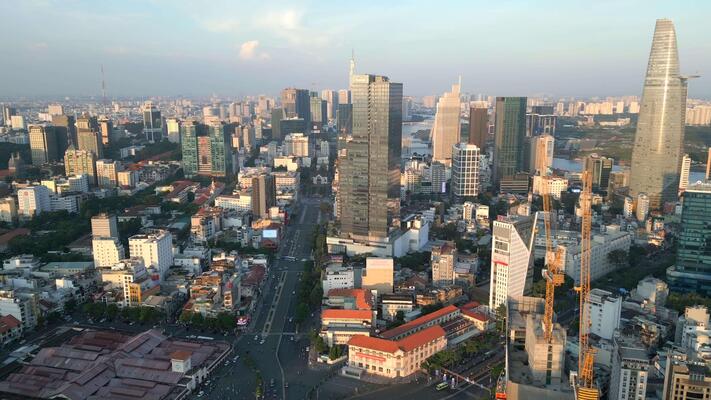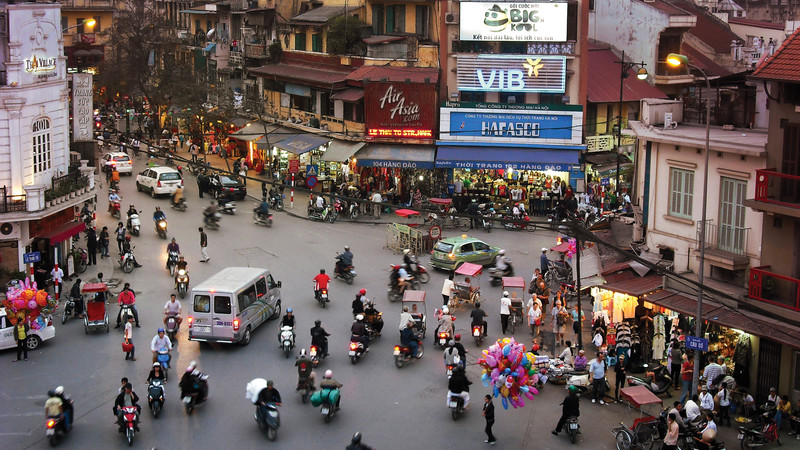When most visitors think of Vietnam, they immediately think of bustling streets with motorbikes, beautiful terraced fields, and vibrant
night markets. But beyond these familiar images, Vietnam is entering a new era of modern transportation, namely the metro.
The metro systems in
Hanoi and
Ho Chi Minh City, though young and still developing, not only provide a convenient means of transportation but also a unique perspective on daily life in these rapidly developing cities.
In this blog, we will explore the metro in Hanoi and Ho Chi Minh City to help you see Vietnam from a completely new perspective.
>>>> Read More: Traffic in Vietnam: A Complete Guide to Vietnamese Urban Cities
1. Overview of Metro in Vietnam

Metro in Vietnam is a relatively new but exciting development in the country’s urbanization. Hanoi and Ho Chi Minh City are the first two cities to deploy modern metro systems, designed to ease traffic congestion and provide residents and visitors with a cleaner, faster and more efficient means of transportation.
Although still in the early stages of operation, these metro lines have quickly become a symbol of Vietnam’s modernization, combining convenience and modernity. For travelers, the metro in Hanoi and Ho Chi Minh city is not only a means of transportation from one place to another, but also a safe, economical and fast way to explore.
2. Metro Map in Hanoi

The Hanoi Metro is Vietnam’s first urban rail system, marking an important milestone in the modernization of the capital’s public transportation. Currently, it consists of two lines:
Line 2A (Cat Linh – Ha Dong), which officially opened on November 6, 2021, is the city’s first fully operational metro line. With 12 stations, it runs along one of Hanoi’s busiest corridors, providing a much faster and more reliable alternative to the often congested streets.
Line 3 (Nhon – Hanoi Station) is the second line, partially operational since August 8, 2024. The elevated section with 8 stations is already serving passengers, while the underground extension toward Hanoi Station is still under construction and expected to be completed by around 2027.
The long-term master plan envisions a total of eight lines, which will form an extensive metro network covering the capital and surrounding areas. Once completed, it is expected to significantly ease traffic congestion, improve connectivity between districts, and reshape urban mobility in Hanoi.
Tickets are easy to buy at train stations, from vending machines or ticket counters. Ticket prices are very affordable, ranging from 8,000 to 15,000 VND for one way depending on the distance. If you plan to visit several stops in a day, a daily ticket costs just 30,000 VND, while frequent travelers can opt for a monthly ticket for 200,000 VND. This makes your travel not only convenient but also cost-effective.
For planning your journey, viewing the
Hanoi metro map, and checking the latest schedules and station details, you can visit the official website:
https://metrohanoi.vn/.
3. Metro Map in Ho Chi Minh City

The Ho Chi Minh City Metro Line marks a major milestone in Vietnam’s urban development. The city’s first line, Line 1, officially opened on December 22, 2024, connecting Ben Thanh Market in District 1 with Suoi Tien Station in Thu Duc City.
Line 1 is 19.7 km (12.2 miles) long and consists of 14 stations, with three underground stations Ben Thanh, Ho Chi Minh City Opera House, and Ba Son and eleven elevated stations serving key areas such as the National University, the High Tech Park, Thu Duc, and Thao Dien.
The line operates 17 three car Hitachi trains, reaching speeds of up to 110 km/h above ground and 85 km/h underground, with the Long Binh depot serving as the main maintenance center.
Using the
Ho Chi Minh metro map, travelers can plan their journeys efficiently, identify station locations, and choose the fastest routes. The Ho Chi Minh metro map is available online on the
official website and at stations, making it easy for both first time visitors and daily commuters to navigate the system.
Tickets are affordable, ranging from 6,000 – 20,000 VND for a single journey, while day passes cost 40,000 VND and three-day passes are available for 90,000 VND, providing convenient options for both residents and tourists.
Line 1 is expected to significantly reduce traffic congestion and improve urban mobility. There are plans to extend the line to An Ha Depot, bringing the total length to 40.8 km. Additional metro lines are also under construction or planned, gradually forming a modern, extensive network throughout Ho Chi Minh City, making public transport faster, safer and more efficient.
4. Important Notes While Taking the Metro in Vietnam
Whether you choose to take the metro in Hanoi or Ho Chi Minh City, there are safety guidelines and etiquette to follow to ensure a smooth journey.
4.1. Check the metro map
Before boarding, check out the
Hanoi metro map or the
Ho Chi Minh City metro map to plan your route efficiently and avoid confusion. If you need transportation to ride to the metro line, it is suggested to book a
Grab ride!
4.2. Safety rules on the metro in Vietnam
- When traveling on the metro in Vietnam, whether on the Hanoi Metro or the Ho Chi Minh Metro, passengers must not bring flammable or dangerous materials.
- Eating, drinking, and smoking are strictly prohibited inside the metro in Vietnam.
- Activities such as skateboarding, rollerblading, or climbing over safety barriers at elevated stations are not allowed.
- Keep conversations quiet and avoid playing music or videos at high volume to maintain a comfortable environment for all passengers.
4.3. Platform and Boarding Safety
Foods with strong odors must be sealed in plastic bags to prevent smells or spillage, and balloons are not allowed in the metro in Vietnam’s stations.
Always stand behind the yellow safety line, do not lean against train doors, and never open windows or cross the tracks.
It is strictly forbidden to board or exit the train while the doors are closing for safety reasons.
4.4. Prohibited Activities
Passengers should also respect social norms: harassment, insults, offensive language or fighting will not be tolerated.
Unauthorized performances, filming, or advertising must be approved by official permission.
Street vending or soliciting is prohibited, and carrying weapons or self-defense tools is not permitted.
CONCLUSION
Metro in Vietnam, from the modern Hanoi Metro to the newly opened Ho Chi Minh City Metro, is not only a convenient means of transportation but also a unique perspective on Vietnam’s rapid urban development and vibrant city life. With clean, safe, and affordable rides, travelers can easily explore famous cultural landmarks and local neighborhoods.

Choosing to travel by metro in Vietnam helps reduce traffic congestion, cut carbon emissions and support sustainable tourism in Vietnam. This spirit of responsible tourism is perfectly aligned with the mission of
YESD Travel, a social enterprise dedicated to promoting authentic community-based tourism.
By combining modern urban exploration with meaningful cultural experiences, your travel itinerary in Vietnam will not only be enjoyable but also memorable. So next time you visit Hanoi or Ho Chi Minh City, hop on the metro, explore Vietnam from a new perspective, and don’t forget to join
YESD’s Hanoi responsible tours to connect more deeply with the locals, understand more about their lives.
 Metro in Vietnam is a relatively new but exciting development in the country’s urbanization. Hanoi and Ho Chi Minh City are the first two cities to deploy modern metro systems, designed to ease traffic congestion and provide residents and visitors with a cleaner, faster and more efficient means of transportation.Although still in the early stages of operation, these metro lines have quickly become a symbol of Vietnam’s modernization, combining convenience and modernity. For travelers, the metro in Hanoi and Ho Chi Minh city is not only a means of transportation from one place to another, but also a safe, economical and fast way to explore.
Metro in Vietnam is a relatively new but exciting development in the country’s urbanization. Hanoi and Ho Chi Minh City are the first two cities to deploy modern metro systems, designed to ease traffic congestion and provide residents and visitors with a cleaner, faster and more efficient means of transportation.Although still in the early stages of operation, these metro lines have quickly become a symbol of Vietnam’s modernization, combining convenience and modernity. For travelers, the metro in Hanoi and Ho Chi Minh city is not only a means of transportation from one place to another, but also a safe, economical and fast way to explore. The Hanoi Metro is Vietnam’s first urban rail system, marking an important milestone in the modernization of the capital’s public transportation. Currently, it consists of two lines:Line 2A (Cat Linh – Ha Dong), which officially opened on November 6, 2021, is the city’s first fully operational metro line. With 12 stations, it runs along one of Hanoi’s busiest corridors, providing a much faster and more reliable alternative to the often congested streets.Line 3 (Nhon – Hanoi Station) is the second line, partially operational since August 8, 2024. The elevated section with 8 stations is already serving passengers, while the underground extension toward Hanoi Station is still under construction and expected to be completed by around 2027.The long-term master plan envisions a total of eight lines, which will form an extensive metro network covering the capital and surrounding areas. Once completed, it is expected to significantly ease traffic congestion, improve connectivity between districts, and reshape urban mobility in Hanoi.Tickets are easy to buy at train stations, from vending machines or ticket counters. Ticket prices are very affordable, ranging from 8,000 to 15,000 VND for one way depending on the distance. If you plan to visit several stops in a day, a daily ticket costs just 30,000 VND, while frequent travelers can opt for a monthly ticket for 200,000 VND. This makes your travel not only convenient but also cost-effective.For planning your journey, viewing the Hanoi metro map, and checking the latest schedules and station details, you can visit the official website: https://metrohanoi.vn/.
The Hanoi Metro is Vietnam’s first urban rail system, marking an important milestone in the modernization of the capital’s public transportation. Currently, it consists of two lines:Line 2A (Cat Linh – Ha Dong), which officially opened on November 6, 2021, is the city’s first fully operational metro line. With 12 stations, it runs along one of Hanoi’s busiest corridors, providing a much faster and more reliable alternative to the often congested streets.Line 3 (Nhon – Hanoi Station) is the second line, partially operational since August 8, 2024. The elevated section with 8 stations is already serving passengers, while the underground extension toward Hanoi Station is still under construction and expected to be completed by around 2027.The long-term master plan envisions a total of eight lines, which will form an extensive metro network covering the capital and surrounding areas. Once completed, it is expected to significantly ease traffic congestion, improve connectivity between districts, and reshape urban mobility in Hanoi.Tickets are easy to buy at train stations, from vending machines or ticket counters. Ticket prices are very affordable, ranging from 8,000 to 15,000 VND for one way depending on the distance. If you plan to visit several stops in a day, a daily ticket costs just 30,000 VND, while frequent travelers can opt for a monthly ticket for 200,000 VND. This makes your travel not only convenient but also cost-effective.For planning your journey, viewing the Hanoi metro map, and checking the latest schedules and station details, you can visit the official website: https://metrohanoi.vn/. The Ho Chi Minh City Metro Line marks a major milestone in Vietnam’s urban development. The city’s first line, Line 1, officially opened on December 22, 2024, connecting Ben Thanh Market in District 1 with Suoi Tien Station in Thu Duc City.Line 1 is 19.7 km (12.2 miles) long and consists of 14 stations, with three underground stations Ben Thanh, Ho Chi Minh City Opera House, and Ba Son and eleven elevated stations serving key areas such as the National University, the High Tech Park, Thu Duc, and Thao Dien.The line operates 17 three car Hitachi trains, reaching speeds of up to 110 km/h above ground and 85 km/h underground, with the Long Binh depot serving as the main maintenance center.Using the Ho Chi Minh metro map, travelers can plan their journeys efficiently, identify station locations, and choose the fastest routes. The Ho Chi Minh metro map is available online on the official website and at stations, making it easy for both first time visitors and daily commuters to navigate the system.Tickets are affordable, ranging from 6,000 – 20,000 VND for a single journey, while day passes cost 40,000 VND and three-day passes are available for 90,000 VND, providing convenient options for both residents and tourists.Line 1 is expected to significantly reduce traffic congestion and improve urban mobility. There are plans to extend the line to An Ha Depot, bringing the total length to 40.8 km. Additional metro lines are also under construction or planned, gradually forming a modern, extensive network throughout Ho Chi Minh City, making public transport faster, safer and more efficient.
The Ho Chi Minh City Metro Line marks a major milestone in Vietnam’s urban development. The city’s first line, Line 1, officially opened on December 22, 2024, connecting Ben Thanh Market in District 1 with Suoi Tien Station in Thu Duc City.Line 1 is 19.7 km (12.2 miles) long and consists of 14 stations, with three underground stations Ben Thanh, Ho Chi Minh City Opera House, and Ba Son and eleven elevated stations serving key areas such as the National University, the High Tech Park, Thu Duc, and Thao Dien.The line operates 17 three car Hitachi trains, reaching speeds of up to 110 km/h above ground and 85 km/h underground, with the Long Binh depot serving as the main maintenance center.Using the Ho Chi Minh metro map, travelers can plan their journeys efficiently, identify station locations, and choose the fastest routes. The Ho Chi Minh metro map is available online on the official website and at stations, making it easy for both first time visitors and daily commuters to navigate the system.Tickets are affordable, ranging from 6,000 – 20,000 VND for a single journey, while day passes cost 40,000 VND and three-day passes are available for 90,000 VND, providing convenient options for both residents and tourists.Line 1 is expected to significantly reduce traffic congestion and improve urban mobility. There are plans to extend the line to An Ha Depot, bringing the total length to 40.8 km. Additional metro lines are also under construction or planned, gradually forming a modern, extensive network throughout Ho Chi Minh City, making public transport faster, safer and more efficient. Choosing to travel by metro in Vietnam helps reduce traffic congestion, cut carbon emissions and support sustainable tourism in Vietnam. This spirit of responsible tourism is perfectly aligned with the mission of YESD Travel, a social enterprise dedicated to promoting authentic community-based tourism.By combining modern urban exploration with meaningful cultural experiences, your travel itinerary in Vietnam will not only be enjoyable but also memorable. So next time you visit Hanoi or Ho Chi Minh City, hop on the metro, explore Vietnam from a new perspective, and don’t forget to join YESD’s Hanoi responsible tours to connect more deeply with the locals, understand more about their lives.
Choosing to travel by metro in Vietnam helps reduce traffic congestion, cut carbon emissions and support sustainable tourism in Vietnam. This spirit of responsible tourism is perfectly aligned with the mission of YESD Travel, a social enterprise dedicated to promoting authentic community-based tourism.By combining modern urban exploration with meaningful cultural experiences, your travel itinerary in Vietnam will not only be enjoyable but also memorable. So next time you visit Hanoi or Ho Chi Minh City, hop on the metro, explore Vietnam from a new perspective, and don’t forget to join YESD’s Hanoi responsible tours to connect more deeply with the locals, understand more about their lives.